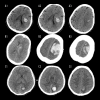Clinical Features of Liver Cancer with Cerebral Hemorrhage
- PMID: 27209058
- PMCID: PMC4918537
- DOI: 10.12659/msm.898642
Clinical Features of Liver Cancer with Cerebral Hemorrhage
Abstract
BACKGROUND Cerebral hemorrhage is common in patients with cancer, but the clinical features and pathogenesis of liver cancer patients with cerebral hemorrhage are not well known. MATERIAL AND METHODS Liver cancer patients who developed cerebral hemorrhage were recruited from the First Affiliated Hospital of Guangxi Medical University between January 2003 and December 2014. We retrospectively analyzed clinical presentations, results of laboratory tests, and imaging examinations. The clinical features and pathogenesis were summarized. RESULTS Among 11133 patients with liver cancer, 9 patients (0.08%), including 3 females and 6 males met the inclusion criteria. The age range was 48-73 years and the average age was 61.67±8.97 years. Five patients did not have traditional hemorrhage risk factors and 4s had the risk factors; however, all had developed hepatocellular carcinoma, and 3 had developed metastasis. All 9 patients showed elevated tumor markers: an increased AFP level was detected in 6 patients, coagulation dysfunctions in 8 patients, and abnormal liver functions in 6 patients. Five patients had developed cerebral hemorrhagic lesions in the lobes of their brains, while hemorrhagic lesions in the basal ganglia occurred in 3 patients and in the brainstem in only 1 patient. Four patients had clear consciousness, while 5 patients were in coma and showed poor prognosis. CONCLUSIONS Patients who have liver cancer complicated with cerebral hemorrhage usually lack traditional risk factors of cerebral hemorrhage. The site of cerebral hemorrhage is often detected in the lobes of the brain. Coagulation dysfunctions might be the main pathogenesis of liver cancer complicated with cerebral hemorrhage.
Figures

References
-
- Rogers LR. Cerebrovascular complications in patients with cancer. Semin Neurol. 2010;30(3):311–19. - PubMed
-
- Velander AJ, DeAngelis LM, Navi BB. Intracranial hemorrhage in patients with cancer. Curr Atheroscler Rep. 2012;14(4):373–81. - PubMed
-
- Hsieh MJ, Lu CH, Tsai NW, et al. Prediction, clinical characteristics and prognosis of intracerebral hemorrhage in hepatocellular carcinoma patients with intracerebral metastasis. J Clin Neurosci. 2009;16(3):394–98. - PubMed
-
- Zhang YY, Chan DK, Cordato D, et al. Stroke risk factor, pattern and outcome in patients with cancer. Acta Neurol Scand. 2006;114(6):378–83. - PubMed
-
- Zoller B, Ji J, Sundquist J, Sundquist K. Risk of haemorrhagic and ischaemic stroke in patients with cancer: A nationwide follow-up study from Sweden. Eur J Cancer. 2012;48(12):1875–83. - PubMed
MeSH terms
LinkOut - more resources
Full Text Sources
Medical
Miscellaneous

